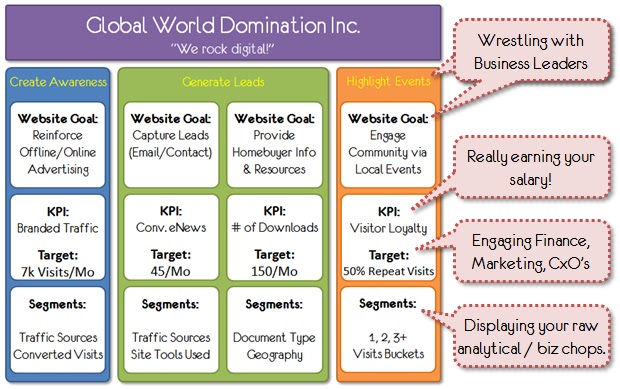This weekend as I was at the Integrate 2012 conference listening to the morning general session speaker, Dave Pavelko, the Head of Google Travel spoke of Avinash Kaushik. Thanks to my IMC 642 class, for once in my life I felt techie and “in the know” – Kaushik wrote the textbook for my class. It was at that moment that I had one of those aha moments! Holy cow, I’m starting to get it! This is exactly why I decided to enroll in the DMC program so that I could stay current on trends and comfortable in the digital world as a marketer. I took a minute to relish in the moment and feel proud that I was on the right path and was one of the few in the audience who had even heard of Kaushik.
The name of my blog is a direct bow to Kaushik whose book “Web Analytics 2.0: The Art of Online Accountability and Science of Customer Centricity” teaches you in easy terms how to be a web analysis ninja. After one week of my class and a few chapters into the book, I am already looking deeper into for my agency’s website statistics and am making plans for changes for next year (which conveniently for us starts July 1).
According to the Adobe 2012 Digital Marketing Optimization Survey released last week, “When asked to identify the top five optimization strategies they intend to employ this year, marketers cited website analytics and social media analytics.” (ClickZ, 2012)
Whew! Maybe I’m not so behind after all if over half of marketers have the same plan as me for next year.
“The survey found that 53 percent of digital marketers fail to optimize on-site search results and 26 percent "manually tweak" results - meaning that marketers are potentially missing a big opportunity to convert visitors into customers. Optimizing site search ‘is about guiding visitors to exactly what they want to find, enhancing overall navigation, and providing an efficient path for users to meet their goals,’ the report said.” (ClickZ, 2012) This seems like such a simple concept, design your site so that visitors can find exactly what they want. Often many of us get sucked into the corporate model of putting the jargon on the web that the board wants that we lose sight of usability.
According to Kaushik, “the single biggest mistake web analysts make is working without purpose” (Kaushik, 2012). Check out Kaushik’s “five step process that forces the engagement of key stake holders to produce a blueprint of why digital exists in a company, and what it is trying to accomplish.”
“You should decide what you are and what you want to measure…Design your own metric system.” (Wasserman, 2012)
How do I plan to do this? By digging deeper into my web reports. “Custom reports…are hand crafted by you for a specific purpose with a set of guiding principles ("Acquisition, Behavior, Outcomes! ") that ensure that they don't so much deliver data as much as deliver insights.” (Kaushik, 2012)
Once completed, I believe that I will have earned my white belt and will be well trained in the basics to pursue my web analysis ninja status.
References:
ClickZ. (2012, June 1). 56% Plan to Use Social Media Analytics in 2012. ClickZ Marketing News & Expert Advice. Retrieved June 4, 2012 from http://www.clickz.com/clickz/news/2181932/56-plan-social-media-analytics2012?utm_source=feedburner&utm_medium=feed&utm_campaign=Feed%3A+clickz+%28ClickZ+-+News%29
Kaushik, A. (2012, February 20) The Biggest Mistake Web Analysts Make…And How To Avoid It! Retrieved June 4, 2012 from http://www.kaushik.net/avinash/google-analytics-custom-reports-paid-search-campaigns-analysis/
Kaushik, A. (2012, June 4) Google Analytics Custom Reports: Paid Search Campaigns Analysis. Retrieved June 4, 2012 from http://www.kaushik.net/avinash/google-analytics-custom-reports-paid-search-campaigns-analysis/
Wasserman, T. (2012, May 5). Why Marketing Is Broken and How to Fix It. Mashable. Retrieved June 4, 2012 from http://mashable.com/2012/05/05/cindy-gallop-marketing-connect/


No comments:
Post a Comment